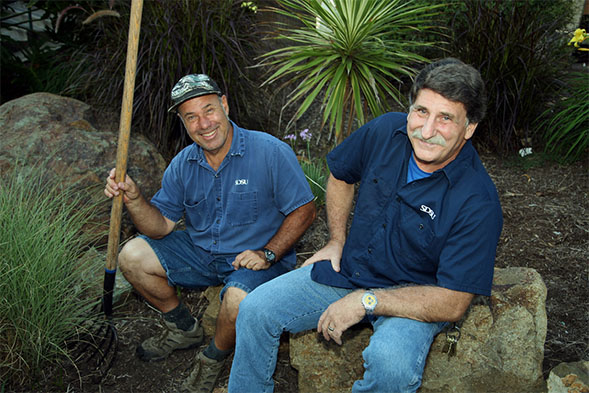How Does Your Garden Grow?
Drought-tolerant plants add color to the campus while reducing water consumption.

This story appears in the fall 2015 issue of 360: The Magazine of San Diego State University.
A prolonged drought is transforming San Diegans’ perceptions of sustainable landscaping, and that presents new challenges for the people who maintain one of the most beautiful campuses in Southern California.
“We have to change the mindset of landscape management at San Diego State University and do it fast,” said Josh Koss, recently hired for the new position of manager, landscape services.
Along well-travelled pathways bordering the SDSU Library and the new Conrad Prebys Aztec Student Union, thirsty shrubs have been replaced by colorful succulent gardens. Drought-tolerant lantana and ornamental grasses add color to the area outside the trolley station without adding to campus water consumption.
These examples of water-wise landscaping are just a piece of the comprehensive drought response plan to cut back water use on the 280-acre campus. In the January through August period, SDSU’s water consumption fell 12 percent from 2014 to 2015—the result of a strategy that includes reusing runoff from SDSU’s cogeneration plant, collecting rainwater in storage tanks for irrigating the campus and changing out toilets, shower heads and sink aerators across campus.
The conservation efforts have been led by Facilities Services, but next spring, SDSU students will take a turn at converting a 60-by-80-foot grass area on campus into a little piece of sustainable paradise. Diana Gauss Richardson, a geography department lecturer and adviser, is restructuring her Recreational Land Use class into a laboratory for experiential learning.
Guided by Richardson and a professional landscape architect, students will find a grassy space at SDSU that’s underutilized and redesign it with drought-tolerant plants, trees, benches, tile and stones.
“We’ll talk about what makes a space appealing and how we can create that appeal while reducing the amount of water, chemicals, fertilizer and even the energy used by lawn mowers,” Richardson said.
Eventually, students will work with Facilities Services to physically make over the space, supported by a $28,000 grant from the California State University Chancellor’s Office that was submitted jointly by Richardson, Koss and Tom Abram, assistant director for campus sustainability.
There is precedent for student involvement in beautifying Montezuma Mesa. For years, students in Michael Simpson’s biology lab have planted and tended campus gardens within SDSU's Mediterranean Garden, from which they harvest samples to study in class.
But the endeavor between Richardson’s geography students and Facilities Services takes campus collaboration to a new level, and at a time when students increasingly care about sustainability.
“Our aesthetics are informed by our ethics,” Abram said. “We want SDSU to be a leader in conserving water and adapting to our changing climate conditions.”



